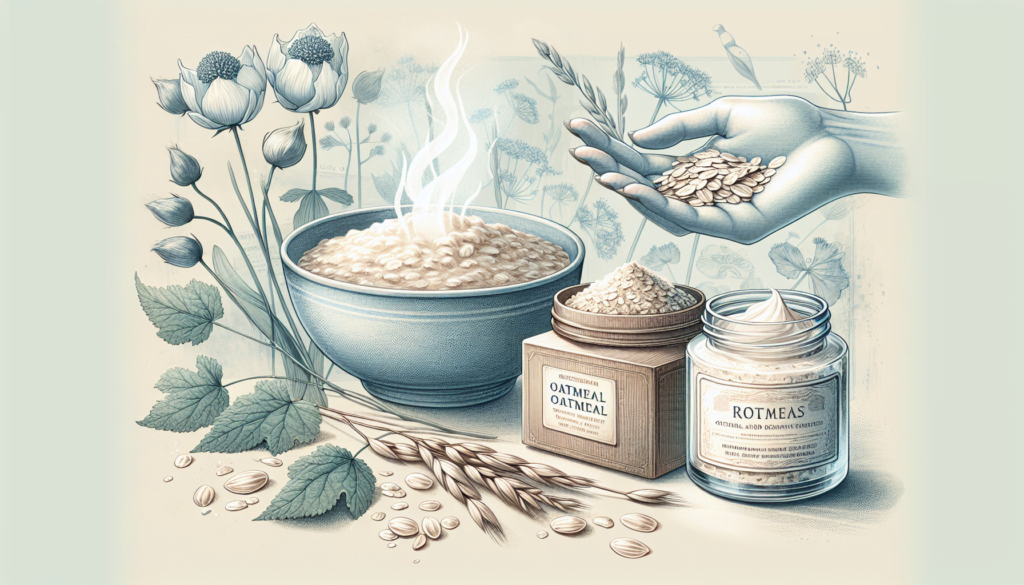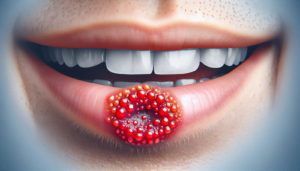If you’re looking for a natural and delicious way to relieve the symptoms of rosacea, you might want to consider adding a bowl of oatmeal to your daily diet. Not only is oatmeal a healthy and filling breakfast option, but it also contains properties that can help reduce redness and inflammation associated with rosacea. By incorporating this humble grain into your routine, you can potentially find some much-needed relief for your skin.

Benefits of Eating Oatmeal for Rosacea
Rosacea, a chronic skin condition characterized by redness, inflammation, and sensitivity, can be a frustrating condition to manage. While there is no cure for rosacea, incorporating certain foods into your diet can help alleviate symptoms and promote healthier skin. One such food is oatmeal, a versatile and nutritious grain that has been found to have numerous benefits for individuals with rosacea. From its anti-inflammatory properties to its soothing effect on the skin, oatmeal can be a game-changer in managing your rosacea symptoms.
Anti-inflammatory Properties
Inflammation is a key contributor to the redness and swelling associated with rosacea. Oatmeal contains compounds known as avenanthramides, which have powerful anti-inflammatory effects on the body. These compounds help reduce the production of inflammatory cytokines, molecules responsible for triggering and sustaining inflammation. By incorporating oatmeal into your diet, you can help calm the inflammation that contributes to rosacea flare-ups, leading to a reduction in redness and irritation.
Rich in Antioxidants
Oatmeal is also packed with antioxidants, which play a crucial role in protecting your skin against damage caused by free radicals. Free radicals are highly reactive molecules that can damage skin cells and accelerate the aging process. The antioxidants found in oatmeal, such as vitamin E and selenium, help neutralize these free radicals, preventing oxidative stress and maintaining the health of your skin. By including oatmeal in your daily routine, you can provide your skin with an extra dose of antioxidants, keeping it healthy and youthful.
Soothing Effect on the Skin
One of the remarkable qualities of oatmeal is its ability to provide relief and comfort to irritated skin. Oatmeal has long been used in skincare products due to its soothing properties. When applied topically, oatmeal forms a protective barrier on the skin, locking in moisture and preventing irritation. This same effect can be experienced when consuming oatmeal internally. By incorporating oatmeal into your diet, you can experience a soothing effect on your skin from the inside out, helping to calm rosacea flare-ups and minimize discomfort.
Nutritional Profile of Oatmeal
Oatmeal is not only beneficial for its specific properties that target rosacea symptoms, but it is also nutritionally dense, providing your body with essential nutrients that support overall health. Understanding the nutritional profile of oatmeal can further highlight why it is an excellent addition to your diet if you have rosacea.
Fiber Content
One of the standout features of oatmeal is its high fiber content. Fiber is essential for the proper functioning of the digestive system and plays a significant role in overall gut health. A healthy gut is closely linked to improved skin health, as a disrupted gut microbiome can contribute to inflammatory skin conditions like rosacea. By consuming oatmeal, you can promote a healthy digestive system, which may have a positive impact on your rosacea symptoms.
Vitamins and Minerals
Oatmeal is also a rich source of vitamins and minerals that are important for maintaining optimal health. Vitamin E, found in oatmeal, is known for its antioxidant properties and its ability to promote skin health. It helps protect the skin from the damaging effects of the sun and environmental pollutants. Additionally, oatmeal is a good source of zinc, a mineral that aids in the healing of wounds and supports the immune system. Zinc deficiency has been linked to increased inflammation, making it an important nutrient to incorporate into your diet if you have rosacea. Furthermore, oatmeal contains magnesium, which plays a crucial role in maintaining the skin’s barrier function and regulating inflammation.
Low Glycemic Index
Oatmeal has a low glycemic index, which means it has a minimal impact on blood sugar levels. This is beneficial for individuals with rosacea, as high glycemic foods have been shown to potentially trigger or worsen rosacea symptoms. By opting for foods with a low glycemic index, like oatmeal, you can help stabilize your blood sugar levels and reduce the risk of triggering a rosacea flare-up.
Understanding Rosacea Symptoms
Before diving into the specific benefits of oatmeal for rosacea, it is important to have a basic understanding of the condition and its symptoms.
Overview of Rosacea
Rosacea is a chronic skin condition that primarily affects the face, causing redness, flushing, and visible blood vessels. It can also lead to the development of papules and pustules, similar to acne. Rosacea can vary in severity and presents differently for each individual, making it a challenging condition to manage effectively. While the exact cause of rosacea is unknown, there are numerous triggers that can worsen symptoms and lead to flare-ups.
Common Symptoms
The symptoms of rosacea can range from mild to severe and may include persistent redness, flushing, dryness, stinging or burning sensations, and the development of small bumps or pimples. These symptoms can cause physical discomfort and impact a person’s self-esteem and quality of life. It is crucial to identify and address the triggers that exacerbate these symptoms in order to effectively manage rosacea.
Triggers of Rosacea Symptoms
Triggers of rosacea symptoms can vary from person to person, but some common triggers include exposure to sunlight, hot or cold weather, spicy foods, alcohol, stress, and certain skincare products. By identifying your individual triggers and making lifestyle changes to avoid or minimize their impact, you can significantly reduce the frequency and severity of rosacea flare-ups.

Anti-Inflammatory Effect of Oatmeal
One of the key benefits of oatmeal for rosacea is its anti-inflammatory effect on the skin. Inflammation is a major contributor to the redness, swelling, and discomfort associated with rosacea. Incorporating oatmeal into your diet can help reduce skin inflammation and promote a calmer complexion.
Reduction of Skin Inflammation
The avenanthramides found in oatmeal have been shown to inhibit the production of inflammatory cytokines, which are molecules responsible for triggering and sustaining inflammation in the body. By consuming oatmeal regularly, you can help reduce the production of these inflammatory cytokines, leading to a decrease in overall skin inflammation.
Decreased Redness and Swelling
One of the most visible symptoms of rosacea is redness and swelling, which can be not only physically uncomfortable but also emotionally distressing. The anti-inflammatory properties of oatmeal can help alleviate these symptoms by reducing the inflammation that contributes to their appearance. By incorporating oatmeal into your diet, you may notice a decrease in redness and swelling, resulting in a more even skin tone.
Calming Effect on Rosacea Flare-ups
Rosacea flare-ups can be triggered by a variety of factors, including exposure to triggers and an increase in skin sensitivity. Oatmeal can provide a calming effect on the skin, helping to soothe and reduce the severity of flare-ups. The anti-inflammatory properties of oatmeal, combined with its ability to form a protective barrier on the skin, can help minimize the impact of triggers and promote a calmer complexion during flare-ups.
Antioxidant Properties of Oatmeal
In addition to its anti-inflammatory effects, oatmeal also boasts powerful antioxidant properties. Antioxidants are essential for neutralizing free radicals and protecting the skin from oxidative damage, which can contribute to the development and progression of rosacea symptoms.
Neutralization of Free Radicals
Free radicals are highly reactive molecules that can damage skin cells and accelerate the aging process. They are formed as a result of various environmental factors, such as UV radiation, pollution, and stress. Oatmeal, particularly its antioxidant components like vitamin E and selenium, can neutralize these free radicals, preventing them from causing harm to the skin and reducing the risk of oxidative stress.
Protection against Skin Damage
Constant exposure to the sun’s harmful UV rays can exacerbate rosacea symptoms and lead to long-term skin damage. Oatmeal’s antioxidant properties, combined with its high vitamin E content, provide a layer of protection against UV-induced skin damage. By consuming oatmeal, you can enhance your skin’s defenses and reduce the risk of sun-related flare-ups and long-term skin problems.
Delaying Signs of Aging
Rosacea is often associated with premature aging, as the condition can accelerate the breakdown of collagen and elastin, the proteins responsible for maintaining skin’s firmness and elasticity. Oatmeal’s antioxidant properties help protect these essential proteins from degradation, thus potentially slowing down the aging process associated with rosacea. By incorporating oatmeal into your diet, you may be able to delay the visible signs of aging and maintain a more youthful appearance.
Soothing Effect of Oatmeal on the Skin
Another significant benefit of oatmeal for individuals with rosacea is its soothing effect on the skin. Oatmeal has long been recognized for its calming and nourishing properties, making it an ideal ingredient for topical skincare products. However, consuming oatmeal internally can also provide similar benefits for the skin, helping to relieve itchiness, irritation, and general discomfort associated with rosacea.
Moisturizing and Hydrating Properties
Oatmeal contains natural compounds called beta-glucans, which have moisturizing and hydrating properties. These compounds form a protective layer on the skin, preventing moisture loss and allowing the skin to retain its natural hydration. By including oatmeal in your diet, you can promote moisturized and hydrated skin, reducing dryness and tightness that often accompany rosacea.
Improvement of Skin Barrier Function
The skin barrier is a vital protective layer that acts as a defense against environmental aggressors and moisture loss. In individuals with rosacea, the skin barrier is often compromised, leading to increased sensitivity and susceptibility to flare-ups. Oatmeal, when ingested, can improve the function of the skin barrier by providing essential nutrients and strengthening its structure. This helps to reduce skin sensitivity and minimize the impact of triggers on rosacea symptoms.
Relief from Itching and Irritation
Itchiness and irritation are common symptoms experienced by individuals with rosacea. Oatmeal has soothing properties that can provide relief from these uncomfortable sensations when consumed internally. The anti-inflammatory and moisturizing effects of oatmeal help calm the skin, alleviate itchiness, and reduce the urge to scratch, consequently minimizing the risk of further irritation and potential worsening of rosacea symptoms.
Role of Fiber in Reducing Rosacea Symptoms
Fiber is a crucial component of oatmeal and plays a significant role in promoting overall health and well-being. When it comes to rosacea, incorporating fiber-rich foods like oatmeal into your diet can have a positive impact on your symptoms and overall skin health.
Regulation of Digestive System
Fiber is known for its ability to regulate the digestive system and promote regular bowel movements. A healthy digestive system is closely linked to improved skin health, as it helps eliminate toxins and waste products from the body. By consuming fiber-rich oatmeal, you can support your digestive system, ensuring optimal gut health, and potentially reducing the frequency and severity of rosacea flare-ups.
Enhancement of Gut Health
The gut microbiome, the community of microorganisms living in our digestive tract, plays a crucial role in maintaining overall health, including skin health. Imbalances in the gut microbiome have been linked to various inflammatory skin conditions, including rosacea. Oatmeal’s high fiber content acts as a prebiotic, providing nourishment for beneficial gut bacteria and promoting a healthy balance of microorganisms. By incorporating oatmeal into your diet, you can enhance your gut health, which may have a positive influence on your rosacea symptoms.
Potential Impact on Skin Health
The gut-skin axis refers to the intricate connection between the gut microbiome and the health of our skin. By promoting a healthy gut environment through the consumption of fiber-rich oatmeal, you can potentially improve your skin’s overall health and reduce inflammation. A healthy gut microbiome helps regulate the immune system and reduces systemic inflammation, both of which play crucial roles in the development and progression of rosacea symptoms. Therefore, consuming oatmeal can have a positive impact on your skin health by supporting a healthy gut.
Vitamins and Minerals in Oatmeal
Oatmeal is not only rich in fiber and antioxidants but also contains various essential vitamins and minerals that are beneficial for individuals with rosacea.
Vitamin E
Vitamin E is a powerful antioxidant that helps protect the skin from oxidative stress and environmental damage. Oatmeal is a good source of vitamin E, and incorporating it into your diet can provide a natural boost of this important nutrient. Vitamin E helps strengthen the skin’s barrier function, improves its ability to retain moisture, and reduces inflammation, all of which can contribute to the management of rosacea symptoms.
Zinc
Zinc is an essential mineral that plays a crucial role in wound healing, immune function, and skin health. Individuals with rosacea often have lower levels of zinc in their skin compared to those without the condition. Including zinc-rich oatmeal in your diet can help replenish your zinc stores, promoting optimal skin health and potentially reducing the severity of rosacea symptoms.
Magnesium
Magnesium is essential for maintaining healthy skin and regulating inflammatory processes in the body. Oatmeal contains a significant amount of magnesium, making it an excellent addition to your diet if you have rosacea. Magnesium helps calm the skin, supports the skin barrier function, and contributes to the overall balance of inflammatory processes in the body. By consuming oatmeal regularly, you can ensure an adequate intake of magnesium, which may help improve your rosacea symptoms.
Low Glycemic Index of Oatmeal
The glycemic index (GI) is a measure of how quickly carbohydrates in a particular food raise blood sugar levels. Foods with a high glycemic index can trigger insulin spikes, potentially worsening rosacea symptoms. Fortunately, oatmeal has a low glycemic index, making it a suitable choice for individuals with rosacea.
Stabilization of Blood Sugar Levels
Oatmeal’s low glycemic index means that it releases glucose into the bloodstream at a slower and steadier pace, leading to more stable blood sugar levels. This is beneficial for individuals with rosacea, as fluctuations in blood sugar levels can trigger or exacerbate symptoms. By choosing oatmeal as part of your diet, you can help stabilize your blood sugar levels, minimizing the risk of triggering a rosacea flare-up.
Reduction of Insulin Spikes
High glycemic foods can cause a rapid and significant increase in insulin levels in the body. Insulin spikes have been associated with increased inflammation and the worsening of various skin conditions, including rosacea. By opting for low glycemic foods like oatmeal, you can reduce the occurrence of insulin spikes, potentially leading to a decrease in inflammation and improved management of rosacea symptoms.
Potential Relationship with Rosacea Symptoms
While the direct relationship between the glycemic index of foods and rosacea symptoms is not yet fully understood, several studies have suggested a potential link. By choosing low glycemic foods like oatmeal, you can potentially minimize the risk of triggering or worsening your rosacea symptoms, supporting a healthier complexion.
Implementing Oatmeal in Your Diet
Now that you understand the numerous benefits of oatmeal for rosacea, it’s time to explore how to incorporate this skin-friendly grain into your diet effectively.
Choosing the Right Type of Oatmeal
When selecting oatmeal, opt for whole grain varieties such as steel-cut oats, rolled oats, or old-fashioned oats. These types of oatmeal contain more fiber and retain more of their natural nutrients compared to instant or processed oatmeal. Additionally, choose plain oatmeal without added sugars or flavors to avoid potential triggers and maintain the healthiest option for your skin.
Incorporating Oatmeal into Meals
There are countless ways to enjoy oatmeal and introduce it into your daily meals. Start your morning with a warm and comforting bowl of oatmeal topped with fresh fruits, nuts, or seeds. You can also add oatmeal to smoothies or use it as a binding agent in homemade granola bars or energy balls. As a versatile grain, oatmeal can be incorporated into both sweet and savory dishes, providing a nutritious and skin-friendly mealtime option.
Avoiding Common Triggers and Complementary Foods
While oatmeal itself can be beneficial for rosacea, it is important to be mindful of potential triggers and complement it with other skin-friendly foods. Avoid spicy foods, alcohol, excessive caffeine, and heavily processed or sugary foods, as they can potentially exacerbate rosacea symptoms. Instead, focus on a balanced diet rich in fruits, vegetables, lean proteins, and healthy fats to provide your body and skin with the necessary nutrients for optimal health.
In conclusion, incorporating oatmeal into your diet can have significant benefits for individuals with rosacea. From its anti-inflammatory properties and antioxidant content to its soothing effect on the skin, oatmeal can help minimize the appearance and discomfort of rosacea symptoms. The fiber, vitamins, minerals, and low glycemic index of oatmeal further contribute to its status as a skin-friendly grain. By understanding your own triggers, making dietary adjustments, and choosing oatmeal as a regular part of your meals, you can support healthier skin and manage your rosacea more effectively. So, don’t hesitate to reach for that comforting bowl of oatmeal and nourish your skin from the inside out.


